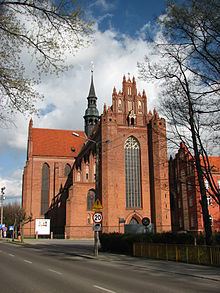Gmina Pelplin Population 8,486 (2006) | Postal code 83-130 Area 4.45 km² Local time Sunday 3:37 AM | |
 | ||
Weather 1°C, Wind NW at 8 km/h, 81% Humidity | ||
Pelplin [ˈpɛlplʲin] is a town in Tczew County, Pomeranian Voivodship, Poland. Population: 9,993 (2007). The former Pelplin Abbey is the seat of the Roman Catholic Diocese of Pelplin, and the abbey church is now Pelplin Cathedral.
Contents
- Map of Pelplin Poland
- Geographical location
- History
- Partitions of Poland
- Return to independence
- Gmina Pelplin
- Twin towns Sister cities
- References
Map of Pelplin, Poland
It is home to one of the finest collections of medieval art in Poland held at the Diocesan Museum in Pelplin.
Geographical location
Pelplin lies in a valley on both sides of river Wierzyca, a left affluent of river Vistula in Pomeralia, which ends up in the Vistula at the town of Gniew. Pelplin is located about 11 kilometres (7 miles) west of the Vistula, 12 km (7 miles) south-east of the town of Starogard Gdański, 19 km (12 miles) south-west the town of Tczew and 50 km (31 miles) south of the regional capitol of Gdańsk. It is surrounded by a chain of little hills, its altitude varies between 8 metres (26 feet) above sea level at the lowlands of the Vistula in the east and 86 metres (282 feet) above sea level at 'Czubatka' hill in the west.
History
Archaeological findings have revealed that human settlements existed in the region of the town already during the Stone age and the Bronze Age.
The history of Pelplin is tightly interwoven with the history of the Monastery of Pelplin, which according to the monastery's chronicle was founded in 1274 by Mestwin II, Duke of Pomerania. The monastery of Pelplin had a forerunner in the monastery of the Cistercians in Pogutken located at the upper course of the Wierzyca, which had been founded in 1258 by Sambor II, Duke of Pomerania. In 1276 the monks, which had come from the Monastery of Doberan in Mecklenburg to Pogutken, begun to transfer their monastery to Pelplin.
From Pelplin, the German monks organized an extensive settlement campaign. They brought in dispossessed farmers and craftsmen and founded a number of German villages in the area. The initiative came from Duke Sambor II, who wanted to compensate population losses of the past, which had occurred because of wars with Pomeralia's neighbours, the Kingdom of Poland in the south and the Old Prussians in the east. During the 12th century, Polish dukes gained control over Pomeralia.
The monks also begun to build an impressive Gothic cathedral, now the Pelplin Abbey, using mainly bricks as construction material. According to the monastery's chronicle, work on the building was taken up already prior to 1294 by Mestwin II, Duke of Pomerania, and was completed during the second half of the 14th century, amounting to a building time of almost 200 years. The monastery was attached to the southern side of the cathedral. It was enlarged considerably during subsequent centuries. The cathedral of the Cistercians, now Pelplin Abbey, is recognized as one of the most important examples of sacral architecture in the Vistula region.
As far as matters concerning the church were concerned, the region of Pelplin was at that time subordinated to the administration of the Diocese of Gniezno.
In 1310 the Teutonic Order captured Gdańsk Pomerania and incorporated it into the monastic State of the Teutonic Order. In 1466, after the Second Peace of Thorn, the region became part of Kingdom of Poland, as the autonomous province of Royal Prussia. During subsequent years several Jagiellonian kings visited Pelplin Abbey, among them Zygmunt III and Jan III Sobieski. During the reformation, the last abbot of the monastery of Doberan moved in 1552 to the affiliated monastery of Pelplin.
Partitions of Poland
In 1772, after the First Partition of Poland, Gdańsk Pomerania was annexed into the Kingdom of Prussia as the new province of West Prussia.
In 1819 the convent of Pelplin was suppressed. After the monastery buildings had been modified, they were utilized since 1824 as the seat of the Bishopric of Culm, which was moved to Pelplin. By that time Pelplin had remained a small village with several pubs. Since 1824 it begun to develop rapidly due to the accommodation of a number of ecclesiastical and clerical institutions. In 1238 a training school for priests was founded, and since 1835 there existed also the Collegium Marianum, an episcopal Progymnasium.
The economical development of Pelplin accelerated after 1852, when the village was connected to the new railway line Bydgoszcz—Gdańsk. In 1905 there existed in addition a supreme forestry superintendent's office, an engineering-works and a sugar factory. Up to 1920 Pelplin belonged to Kreis Dirschau in the administrative district of Regierungsbezirk Danzig in West Prussia.
Return to independence
After World War I as a consequence of Treaty of Versailles the Polish Corridor was created, and Pelplin was integrated into the Second Republic of Poland. In 1925 the bishopric of Culm was renamed as bishopric of Pelplin. In 1939, after the Nazi invasion of Poland, Gdańsk Pomerania was annexed by German Third Reich and incorporated into the newly formed province of Reichsgau Danzig-West Prussia. During World War II Pelplin was captured by the Red Army. After the end of war Pelplin became part of People's Republic of Poland and received city rights.
Gmina Pelplin
The Gmina Pelplin is based on the historical administrative rural district of Amtsbezirk Pelplin, which existed prior to 1920. In 1789 the district consisted of three leased farm estates, nine fee-farm type of settlements and of 18 villages and other smaller settlements, comprising all together 602 households. During the aera of the Third Reich some villages were given different German names.
Twin towns — Sister cities
Pelplin is twinned with:
